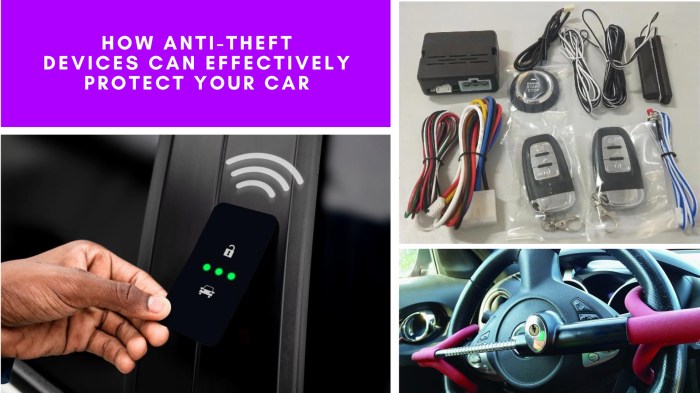The question of whether anti-theft devices impact car insurance premiums is a common one among drivers. Intuitively, it seems logical that enhanced security should lead to lower costs. However, the relationship isn’t always straightforward. This guide delves into the complexities of this issue, exploring how various anti-theft systems affect your insurance rates, and what other factors play a significant role in determining your premium.
We’ll examine the different types of anti-theft devices, their effectiveness in deterring theft, and how insurance companies assess the risk associated with each. Furthermore, we will analyze the cost-benefit analysis of installing these devices, considering both the upfront investment and the potential long-term savings on your insurance premiums. Understanding these dynamics empowers you to make informed decisions about protecting your vehicle and managing your insurance costs effectively.
Impact of Anti-theft Devices on Insurance Premiums

Vehicle security features significantly influence insurance premiums. Insurance companies base their risk assessments on the likelihood of a vehicle being stolen, and anti-theft devices demonstrably reduce this risk. Therefore, installing these devices can lead to lower insurance costs.
Insurance companies consider several factors when determining premiums, and the presence or absence of anti-theft technology is a key component. The type of device, its effectiveness, and the overall security profile of the vehicle are all taken into account. Generally, more sophisticated and comprehensive systems result in greater premium discounts.
Types of Anti-theft Devices and Their Impact on Premiums
The effectiveness of different anti-theft devices varies, leading to different levels of premium discounts. Alarms, while offering a deterrent, typically provide smaller discounts than more sophisticated systems. GPS trackers, which allow for vehicle location and recovery, often garner larger discounts. Immobilizers, which prevent the engine from starting without the correct key, are highly valued by insurers and often result in substantial premium reductions.
For example, a hypothetical scenario: Let’s consider a standard sedan. Without any anti-theft devices, the annual premium might be $1200. With a basic alarm system, this could decrease to $1100 (an 8.3% reduction). Adding a GPS tracker might lower the premium further to $950 (a 20.8% reduction from the original premium). An immobilizer, in addition to the alarm and GPS, could reduce the premium to $800 (a 33.3% reduction from the original). These figures are hypothetical and vary greatly based on numerous factors including location, driver profile, and insurance provider.
Insurance Company Risk Assessment and Vehicle Theft
Insurance companies employ sophisticated risk assessment models to predict the likelihood of vehicle theft. These models consider various factors, including the vehicle’s make, model, year, and location. The presence of anti-theft devices is a crucial factor in these models, as it directly reduces the probability of theft. Data on theft rates for specific vehicle models, combined with the effectiveness of different anti-theft technologies, inform the discounts offered. For instance, vehicles with a history of high theft rates often require more comprehensive security measures to achieve significant premium reductions. A vehicle known for high theft rates with no anti-theft system would likely have a much higher premium than a vehicle with a proven lower theft rate and multiple anti-theft devices.
Factors Affecting Premium Reductions

While anti-theft devices can significantly reduce your car insurance premiums, they are not the sole determinant. Several other factors play a crucial role in how much you pay for car insurance. Understanding these factors can help you make informed decisions about managing your risk and securing the best possible rates.
Insurance companies assess risk based on a variety of factors, carefully weighing each one to determine your premium. Anti-theft devices are one piece of this complex puzzle, contributing to a lower overall risk profile but not overriding other significant elements.
Driving Record and Claims History
Your driving record is a primary factor influencing your insurance premium. A clean record with no accidents or traffic violations will result in lower premiums compared to someone with a history of accidents or speeding tickets. Insurance companies use sophisticated algorithms to assess risk based on the severity and frequency of incidents. For instance, a single at-fault accident might lead to a more substantial premium increase than multiple minor traffic violations. Similarly, a history of making insurance claims, even for minor incidents, can negatively impact your premiums. The more claims you make, the higher your risk profile appears to the insurer.
Vehicle Type and Value
The type and value of your vehicle are key considerations. Sports cars and high-performance vehicles generally attract higher premiums due to their increased risk of theft and higher repair costs. Conversely, less expensive and less desirable vehicles may command lower premiums. The vehicle’s safety features, such as airbags and anti-lock brakes, also influence the premium. Vehicles with advanced safety technology often receive discounts due to their reduced accident risk.
Location and Geographic Risk
Where you live significantly impacts your insurance premium. Areas with high crime rates, particularly car theft, will result in higher premiums. Insurance companies use extensive data analysis to assess the risk of theft, accidents, and other incidents in specific geographic locations. Living in a high-risk area means you’re more likely to pay a higher premium, even with an anti-theft device installed.
The Relative Importance of Anti-theft Devices
While anti-theft devices demonstrably reduce the risk of theft, their impact on premiums is relative to the other factors discussed above. A driver with a poor driving record residing in a high-risk area might see a smaller percentage reduction in their premium from installing an anti-theft device compared to a driver with a clean record in a low-risk area. The device acts as one element contributing to a lower risk profile, but it’s not a guaranteed solution for significantly reducing premiums in high-risk scenarios.
Insurance Company Assessment of Anti-theft Technologies
Insurance companies carefully evaluate the effectiveness of different anti-theft technologies. They consider factors like the technology’s sophistication, its resistance to bypass attempts, and the availability of professional installation and maintenance services. Systems that are easily disabled or circumvented will offer less significant premium reductions. Furthermore, the insurer’s specific requirements for qualifying for a discount may vary. For instance, some insurers might only recognize professionally installed systems meeting certain industry standards.
Comparison of Premium Discounts for Anti-theft Systems
| Insurance Provider | GPS Tracking System | Alarm System | Steering Wheel Lock |
|---|---|---|---|
| Company A | 15% | 10% | 5% |
| Company B | 20% | 12% | 7% |
| Company C | 10% | 8% | 3% |
*Note: These are hypothetical examples and actual discounts vary significantly depending on the specific insurer, policy, and other factors.*
Cost-Benefit Analysis of Anti-theft Devices

Investing in anti-theft devices is a financial decision that requires careful consideration. The potential savings on insurance premiums must be weighed against the upfront and ongoing costs of the devices themselves. This analysis helps determine if the investment is worthwhile in the long run, varying based on individual circumstances and the specific anti-theft system chosen.
Comparing Costs and Insurance Savings
A comprehensive cost-benefit analysis involves comparing the price of different anti-theft systems with the potential reduction in insurance premiums. For instance, a basic steering wheel lock might cost around $20-$50, while a sophisticated GPS tracking system could range from $200 to over $1000, depending on features and subscription fees. Insurance companies typically offer varying discounts, perhaps 5-20% or more, depending on the type of device and the vehicle’s value. Calculating the potential savings requires knowing the current insurance premium and the percentage discount offered for each anti-theft system.
Long-Term Financial Implications
The long-term financial implications extend beyond the initial purchase price. Some systems require ongoing subscription fees for data services or monitoring. Others may necessitate periodic maintenance or replacement of components. Conversely, the insurance savings accrue over the policy period, potentially offsetting the initial investment and ongoing costs within a reasonable timeframe. For example, a $300 GPS tracker offering a 15% discount on a $1200 annual premium yields a $180 annual saving. This would recover the initial investment within two years, ignoring maintenance or subscription fees.
Scenarios Where Costs Outweigh Savings
There are scenarios where the investment might not be financially beneficial. For vehicles with low insurance premiums, the percentage discount offered might not significantly offset the cost of high-end anti-theft systems. For example, a $500 alarm system providing a 10% discount on a $300 annual premium results in only $30 annual savings, making the return on investment slow. Similarly, older vehicles with lower values may not justify the expense of sophisticated anti-theft technologies due to the relatively small insurance premium and thus smaller potential savings. The cost of installation should also be considered, as this can add significantly to the total expenditure.
Step-by-Step Cost-Benefit Analysis
A step-by-step guide for conducting a cost-benefit analysis involves the following:
- Determine Current Insurance Premium: Obtain your current annual car insurance premium.
- Research Anti-theft Devices: Research available anti-theft devices, noting their prices and any associated subscription or maintenance costs.
- Obtain Insurance Discounts: Contact your insurance provider to inquire about discounts offered for each anti-theft device considered.
- Calculate Annual Savings: For each device, calculate the annual savings based on the insurance discount.
- Calculate Total Cost: Calculate the total cost of each device, including installation, subscriptions, and any anticipated maintenance.
- Determine Payback Period: Divide the total cost of each device by the annual savings to determine the number of years it takes to recoup the investment.
- Compare Options: Compare the payback periods and choose the option that offers the best balance between cost and savings.
Summary
Ultimately, the impact of anti-theft devices on your car insurance premiums is multifaceted. While they generally lead to lower rates due to reduced risk, the extent of the discount varies depending on the type of device, your insurance provider, and other risk factors. A thorough cost-benefit analysis, considering the specific features of available anti-theft systems and your individual circumstances, is crucial for making an informed decision. By understanding how insurance companies assess risk and by choosing the right security measures, you can effectively manage your insurance costs and protect your investment.
FAQ Summary
What types of anti-theft devices are most effective in lowering premiums?
Insurance companies generally favor devices that offer multiple layers of protection, such as immobilizers combined with alarms and tracking systems. The specific preferences vary by insurer.
Do all insurance companies offer discounts for anti-theft devices?
No, not all insurance companies offer discounts, and the discounts offered can vary significantly. It’s essential to check with your individual provider.
How do I prove I have an anti-theft device installed to my insurer?
Typically, you’ll need to provide proof of purchase and installation, such as receipts and possibly a professional installation certificate.
Can I get a discount for an older anti-theft system?
Possibly, but the discount might be smaller than for newer, more sophisticated systems. Check with your insurer.